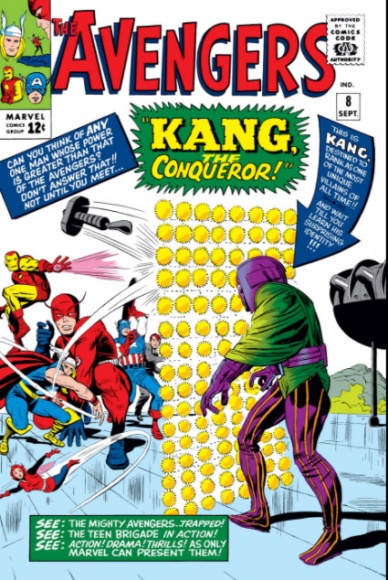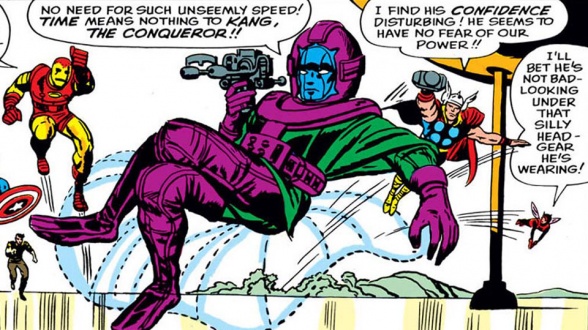The Avengers are a self-obsessed franchise. Avengers plots are often at their best when they explore and expand wrinkles in team history ― think ‘Avengers Forever,’ ‘The Once And Future Kang,’ or countless Ultron stories that knot the Pym/Williams/Vision/Ultron family ties in increasingly nuanced ways. The Avengers are a super team that makes their members study the team’s own continuity like a comic reader pouring over an Official Handbook of the Marvel Universe. Because of this running focus on team history, it always feels natural when the Avengers face off against (or occasionally team up with) Kang the Conqueror ― a villain who controls and flows through time and history itself. Virtually every significant “Avengers” writer has examined the villainy of Kang, frequently to great effect. In this column, I’d like to examine Kang’s first showdown with Earth’s Mightiest Heroes in “Avengers” #8 to learn which traits were built into the character from the start.

“Avengers” #8 was written by Stan Lee, penciled by Jack Kirby, inked by Dick Ayers, and lettered by Sam Rosen. The issue was published in September, 1964. For context, this was the month after Lee and Kirby produced “Fantastic Four” #29, “It Started on Yancy Street!” In my column last month, I argued that when you hold up Kirby’s work on the first eight issues of “Avengers” against his work on “Thor” or “Fantastic Four,” those “Avengers” issues do not shine as brightly in comparison. Comparing Avengers #8 with Fantastic Four #29 illustrates this point well. That issue of Fantastic Four toggles rapidly and masterfully between visual comedy, action, unsettling sci-fi, and an early example of Kirby’s photo-collage experimentation.
There are flashes of that Kirby genius in “Avengers” #8. Kang’s costume design clearly conveys futuristic, regal, and flamboyant vibes while still being jarringly original. On the issue’s cover, he creeps towards a huddled line of Avengers who are baffled by the fact that their powers are useless against him. My favorite moment comes when our heroes first see Kang. They see him lounging on a floating pillow, purple legs crossed casually while gazing at some chunk of technology, apathetic to the superheroes charging at him. But overall, unlike the “Fantastic Four,” these early issues of “Avengers” just don’t have a cohesive feel from page to page. The Lee/Kirby “Fantastic Four” issues transport me. Lee/Kirby “Avengers” issues thoroughly entertain me, but never transcend the medium in the same way.

The most compelling and enduring aspect of Kang’s personality is a supreme arrogance (not uncommon in supervillains) that is coupled with a regal bearing (less common in supervillains). Kang does not simply want to conquer the earth, he feels that he deserves to rule the earth. His sense of superiority stems from his mastery of time itself as he explains to the Avengers, “Remember, more than a thousand years separate my knowledge from yours! To me, you are like bumbling children, trying to break out of your playpen!”

Of course, through their ingenuity and persistence, the Avengers send Kang scurrying back through time. I love the concept of relatively primitive but determined heroes defending their 20th century Earth like a fort. The idea that Earth is an underdog planet against cosmically powerful hostile agents is a theme strongly established in early Marvel comics. Most notably when the Fantastic Four fend off Galactus.

The most significant takeaway I had from “Avengers” #8 pertained to the nature of Kang’s origin. In “Fantastic Four” #19 and “Fantastic Four Annual” #2, there was a character named Pharaoh Rama-Tut who ruled in ancient Egypt but was actually a time-traveler from the far future. In “Avengers” #8, Kang reveals that he is this same man, who has now reinvented himself as a conquering warlord after having spent time in a dystopic future.

So many modern comics are built from mining scraps of continuity ― taking a small character or a forgotten plot point and expanding those ideas into years of stories. This happens so frequently now that we take it for granted, but when Kirby and Lee took a Pharaoh from one comic, sent him on an adventure into the far future, and then sent him back in time as a flamboyant purple conqueror to terrorize the Avengers, they were helping to expand the very idea of what continuity could do. Up to this point in comics, continuity was basically a copy/paste function. The Hulk would show up in his book, then he would show up in another character’s book, and so on.

In Avengers #8, continuity isn’t simply pasting one character into a new setting. Lee and Kirby treat chucks of plot like raw ore and melt them down into a malleable, pliable substance. When you read this story, you can witness Lee and Kirby becoming pioneering sculptors of continuity.






